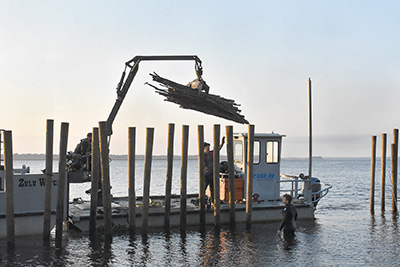Environment
Bringing a shoreline back to life

Five years after Morgan Park in Georgetown was chosen as the site of a living shoreline, the work is almost complete.
Zulu Marine Services of Savannah is putting on the finishing touches this week.
“Everything went well,” said Shannon Merino of Zulu. “It’s gone as planned.”
Morgan Park, which is is adjacent to East Bay Park, overlooks the upper part of Winyah Bay where the Sampit River meets the waters of the Pee Dee and Black rivers.
Living shorelines use plants or other natural elements — sometimes in combination with harder shoreline structures — to stabilize estuarine coasts, bays and tributaries.
Robinson Design Engineers picked the materials for the project with the confluence of the area’s five rivers in mind.
“The type of living shoreline we’re doing here is kind of new for South Carolina,” said Nolan Williams, who helped design the project. “It’s some slightly different methods that haven’t been done.”
Williams said the goal was to “mimic” natural processes and help the ecosystem heal itself.
“Here we’re relying on vegetation and wooded material because that’s what nature would be doing if we were not to do anything,” he said. “Those are the materials that would naturally be working to stabilize the shoreline.”
Work on the project started years before the state even approved a definition of a living shoreline or a permit, which happened in May 2022.
According the Liz Fly, the project’s manager, since Georgetown was chosen, the erosion in Morgan Park has gotten worse.
The entire project covers about an acre and includes manufactured wire reefs, wooden breakwaters and wattle fence sills.
The 104 reefs were created by students at Carvers Bay Early College and Career High School. The students used more than two cubic yards of oyster shell, 3,600 square feet of wire and 100 pounds of coconut coir fiber to create the reefs, which look like cages.
The goal is for baby oysters to settle in the reefs and grow because an adult oyster can filter 50 gallons of water a day.
Healthy oyster reefs are known to attract other creatures such as shrimp, crabs, fish and shorebirds.
The wooden breakwaters absorb wave energy instead of redirecting it like a seawall would.
Wood from Hobcaw Barony was used to create the 63 wattle fence sills, which were placed between the breakwaters to disperse wave energy, slow erosion and trap sediment.
Work on the project was not even delayed when the far-reaching winds of Hurricane Helene swept over the county last month.
“We fared well through the storm,” Merino said. “It performed exactly to the expectations of the engineers. It did exactly what they wanted it to do.”
The manufactured wire reefs actually trapped sand during the storm, slowing down the erosion.
“It’s really, really cool stuff,” Merino said.
The Darnall W. and Susan F. Boyd Foundation donated $997,000 toward the $1.4 million project.
“Morgan Park is one of the city’s most frequented parks along the shoreline of Winyah Bay. The Boyd Living Shoreline is a welcomed project from The Nature Conservancy in helping to retain this shoreline by helping with current and future erosion,” Georgetown Mayor Carol Jayroe said.
The benefits to the community are wide-ranging, she added.
“Especially exciting is the benefits that will be gained aquaculturally by re-establishing a strong habitat for shrimp, crab, fish, and others,” Jayroe said. “We are grateful that this iconic park is being protected and stabilized by this most important project.”
Staff from The Nature Conservancy and Robinson Design Engineers will monitor the project going forward.
Merino said over time there may be some maintenance his company has to do, such as replacing some of the manufactured wire reefs or wattle fence sills, but for the most part his work is done.
“It’s one of those ‘time may tell’ things,” he added. “We’ll watch and see.”
The state Department of Natural Resources has done hundreds of shoreline projects, like oyster shell recycling, since the late 1990s. But it was years before anyone called them living shorelines.




